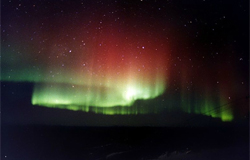Weather and the Northern Lights
WEATHER CONDITIONS
Weather conditions are of the utmost importance if you want to see the lights. A cloud here and there might make for better pictures; but if the sky is filled with clouds or it’s snowing you won’t see anything at all. Clouds block the aurora so your only chance is a clear sky or large gaps between the clouds. Keep in mind that the aurora happens above the cloud cover; if there's a cloud cover, then the lights are... covered.
There are many weather forecast services available. weather.com or accuweather.com are good options for checking weather conditions. Good weather services such as the above have nice apps that you can use to check weather on the field in realtime. Also, be sure to check the hourly forecast not just the daily one, as conditions change rapidly.
Weather.com has historical monthly and daily precipitation averages and weather conditions (select your location, click on "More forecasts" and select "Monthly", then select your desired months); be sure to check them for your selected location beforehand to assist in selecting the exact dates for your visit.
Weather patterns may vary in terms of temperature as well, raising another problem: it gets very, very cold on your aurora hunting trips. Locations on the coast may be warmer than inland ones, sometimes with a difference of 20 to 30 degrees Celsius (centigrade). -10 or -15 in Tromso could mean -40 inland at the same latitude.You will need to prepare accordingly - this is covered in the Logistics chapter of this guide.
SPACE WEATHER
Remember the ring-shaped area discussed in the Where? chapter? There's a catch. The display's intensity and brightness vary depending on space weather, i.e. conditions on the Sun and in the solar wind.
More specifically, the thickness of the aurora ring will change from day to day and from hour to hour. This means that sometimes you'll get a ring that covers larger areas (aurora displays in all locations covered by the ring and in those closeby), and (most) other times you'll have a thinner ring convering fewer locations (hence aurora shows in fewer places). You need to be as close to the action as possible, otherwise you won't see much if intensity is low. Also, the show is much better when the lights are above you, covering the entire sky compared to when the lights are only seen at the horizon.
There's a geomagnetic activity index called Kp that can be forecasted to some extent; it tells us who gets to see the aurora and who doesn't. The index can take values between 0 and 9 on a quasi-logarithmic scale. This is what it all means (Geophysical Institute pictures for Europe):

The first picture above shows the aurora range for the minimum value of Kp=0 (defined as minimum auroral activity), the second for Kp=3 (moderate aurora activity) and the third for the maximum of Kp=9. While you may think you could go to Paris or Frankfurt to enjoy the lights, this only happens once every decade. A Kp value of 3-4 is more common and provides wonderful displays at the right locations (on or close to the medium ring above), while values of 1-2 or even 0 are the most common and provide shows only in a few select locations (on the thinnest ring or close to it). We'll discuss more on forecasting in our Resources & Tours chapter.
You now hopefully have a general idea of where to go and how weather conditions will impact your experience. Our next chapter deals with timing: When? - the best time to see the Northern Lights.

